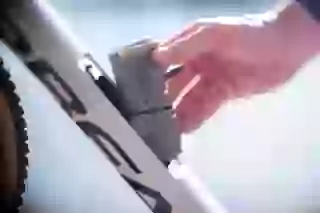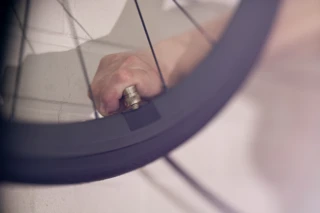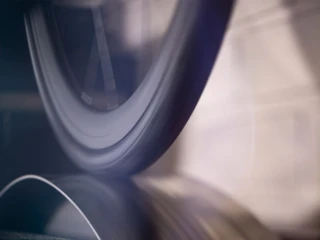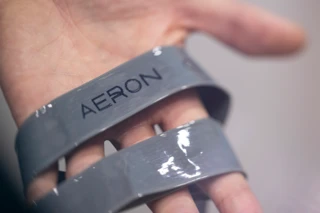Veröffentlicht am
GRAVEL BIKE – TIRE PRESSURE GUIDE
What is the right and optimal tire pressure for a gravel bike? How do changes affect performance, and what should you consider? Here's our guide!

The correct tire pressure is crucial for the performance, comfort, and safety of a gravel bike and its rider. However, there is no universal manual, definitive chart, or fixed reference values that dictate the perfect tire pressure. The correct pressure is influenced by many factors, including:
- Rider weight (sometimes also total system weight)
- Tire width
- Rim width
- Terrain
- System (tubeless or tube)
- Temperature and weather conditions (wet, hot, etc.)
What defines the right tire pressure?
Tire pressure affects a gravel bike’s handling in many ways. Too much pressure may improve puncture resistance but can worsen ride quality and increase the risk of accidents. On the other hand, too little pressure reduces puncture protection and increases rolling resistance and tire wear on both front and rear wheels. An optimally adjusted tire pressure offers the best compromise between rolling resistance, grip, and comfort.
Since terrain conditions can change frequently when riding off-road, it is essential to regularly check and adjust your tire pressure. For example, if you encounter a long stretch of sandy terrain during a bikepacking tour, it may be worth lowering the pressure for a few hours and increasing it again once you're back on firmer ground.
What does "optimal tire pressure" mean?
In the past, before gravel bikes existed and road bikes ruled the roads, it was commonly believed that higher pressure meant more speed. This myth has long been debunked by science and numerous tests. Not to mention that road bike tires used to be narrower than 20 mm. To protect them from pinch flats and punctures, riders often inflated them to 11 or even 12 bar. These were tubular tires, not clinchers with wire or folding beads and inner tubes, but tires sewn together with the tube and glued onto a concave rim bed.
Back then, if you had a flat, you needed a full-sized pump. Mini pumps of the time couldn’t handle the job. Today’s pumps are far more capable. High-performance pumps and mini pumps, such as those from Topeak, are now widely available.
What should the tire pressure be on a gravel bike?
Let’s leave the past behind and focus on the present. Both tire and road bike technology have evolved rapidly, leading to the rise of gravel bikes. Today, gravel bikes are often the top choice for sporty riders looking for a new bike. They combine the best of both worlds: speed and sportiness with the durability needed for off-road adventures and daily urban use.
Many models now come fully equipped with integrated lighting, fenders, and racks. For such versatile bikes, a tire width of 40 mm has become the standard among most consumers. And roughly speaking, a pressure of around 3 bar is common, though this varies depending on terrain, rider weight, and personal preference.
How do you measure tire pressure on a gravel bike?
Tire pressure—meaning the pressure above atmospheric pressure—is usually measured in bar, sometimes in PSI (pounds per square inch). The conversion: 1 bar = 14.5 psi.
Sometimes, a simple thumb press is enough to check the pressure, whether on a mountain bike (MTB), road bike, gravel bike, or trekking bike. If the tire gives slightly, it’s probably fine. However, a proper pressure gauge, like the Topeak Smart Gauge D2X, provides much more accurate readings and helps you achieve better performance, comfort, handling, and safety.

How does rider weight affect gravel bike tire pressure?
Rider weight plays a key role in determining the correct tire pressure. Heavier riders need higher pressure, while lighter riders need less. Tires should compress slightly but not feel squishy or bouncy. For road cyclists, a common rule of thumb is 10% of body weight in bars. So if you weigh 75 kg, you’d inflate your tires to 7.5 bar (while respecting the maximum pressure limits of tires and rims).
For gravel bikes, a better estimate is around 4%. That means you’d ride with about 3 bar. But don’t forget to consider system weight—bikepacking bags, for example, can significantly increase it. Additionally, wider rims enable lower pressures, and the front tire can typically be a few tenths of a bar lower than the rear, which carries a greater load. Most tires have a recommended pressure range printed on the sidewall.
What about wider tires?
As mentioned, most gravel riders use tires at least 40 mm wide. But wider options are available. For example, in races like the Tour Divide—the mother of all bikepacking races—tires around 60 mm are common. These routes often include very rough terrain, entering mountain bike territory. On rugged surfaces like the old tank tracks of the former German border, you might even use 80 mm tires, inflated to just over 1 bar.
Think that’s too low? Not at all. Wider tires significantly increase comfort, which in turn can boost a rider’s overall performance.
Speaking of rolling resistance – what is it, exactly?
Rolling resistance is the force that opposes the motion of a rolling wheel or tire and slows it down. This force mainly arises from the deformation of the tire on the riding surface and from internal friction within the tire itself. The rider’s muscle power must compensate for these energy losses. The faster you ride, the more effort is required to overcome rolling resistance.
While higher tire pressure can reduce rolling resistance, it also decreases comfort. Since gravel paths and even regular asphalt roads are not as smooth as a velodrome track, too much pressure can lead to a bumpy ride. The tire may bounce and vibrate. On gravel and forest trails, as well as uneven roads and cobblestones, it’s better to lower the pressure. Reduced pressure allows the tire to better conform to the terrain, increasing comfort and improving control.

How does rim width affect tire pressure on a gravel bike?
Rim width influences the shape of the inflated tire, aerodynamic drag, and tire pressure. Wider rims allow for wider tires. A wider rim paired with a wider tire generally requires less air pressure to achieve the same performance.
What are the advantages of TPU tubes?
Compared to butyl tubes, TPU (thermoplastic polyurethane) tubes offer several advantages. They are:
- More compact (fits into any jersey pocket)
- More airtight (less frequent need to re-inflate)
- Lighter (on average, 60% lighter than butyl tubes, regardless of bike type)

As mentioned earlier, tire pressure depends not only on terrain but also heavily on rider weight (and total system weight, including rider, bike, and gear), tire width, and the system used (tubed or tubeless).
Here’s a table we’ve adapted for gravel riders based on established road cycling data:
| Rider Weight | Tire Width | Tubeless System | Tube System |
| 60 - 70 kg | 40 mm | 35–45 psi (2.4–3.1 bar) | 40–50 psi (2.8–3.4 bar) |
| 60 - 70 kg | 45 mm | 30–40 psi (2.1–2.8 bar) | 35–45 psi (2.4–3.1 bar) |
| 70 - 80 kg | 35 mm | 40–50 psi (2.8–3.4 bar) | 45–55 psi (3.1–3.8 bar) |
| 70 - 80 kg | 40 mm | 35–45 psi (2.4–3.1 bar) | 40–50 psi (2.8–3.4 bar) |
| 80 - 90 kg | 35 mm | 45–55 psi (3.1–3.8 bar) | 50–60 psi (3.4–4.1 bar) |
| 80 - 90 kg | 40 mm | 40–50 psi (2.8–3.4 bar) | 45–55 psi (3.1–3.8 bar) |
| 90 - 100 kg | 35 mm | 50–60 psi (3.4–4.1 bar) | 55–65 psi (3.8–4.5 bar) |
| 90 - 100 kg | 40 mm | 45–55 psi (3.1–3.8 bar) | 50–60 psi (3.4–4.1 bar) |
These values provide a solid starting point but can be adjusted based on terrain and personal riding preferences. In general, slightly lower pressure is recommended for rough terrain to improve traction and comfort.
Summary
Choosing the correct tire pressure—the one that offers the best traction and comfort for your gravel bike—depends on factors like tire width, terrain, rim width, rider weight, and the tire system used. It’s important to consider all these aspects to ensure optimal performance, comfort, and safety. By testing and adjusting tire pressure to suit your individual needs and conditions, you can get the most out of your gravel bike.